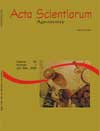<b>Parasitism of <em>Heliothis virescens</em> eggs by <em>Trichogramma</em> spp. can be affected by cotton cultivars</b> - DOI: 10.4025/actasciagron.v31i4.808
Keywords:
biological control, parasitoids, integrated pest management
Abstract
The objective of this work was to evaluate the parasitism of Heliothis virescens eggs on leaves of commercial cultivars of white (BRS 8H) and colored (BRS Safira) cotton fibers, by Trichogramma exiguum, Trichogramma pretiosum and Trichogramma atopovirilia. Thirty eggs of the pest were deposited on leaves of the respective cultivars, and exposed to each species of the parasitoid for 48 hours in controlled conditions, where they were kept until the emergence of their descendants. The parasitism rate was higher on BRS 8H cotton with better parasitism of T. atopovirilia and T. exiguum, followed by T. pretiosum. The parasitism viability was above 90%, and sexual ratio ranged from 0.79 to 1.00 on both cotton genotypes, but with lower values for T. exiguum, followed by T. atopovirilia. The number of descendants per parasitized egg of H. virescens was similar among parasitoid species, with values from 1.69 to 1.9. Overall, T. atopovirilia achieved better results on both cotton cultivars, differing from T. pretiosum. Thus, the performance of these species can be affected by cultivars. The results suggest that differences between plants are the causes of variation in the results of Trichogramma parasitism in the same culture.Downloads
Download data is not yet available.
Published
2009-08-28
How to Cite
Andrade, G. S., Pratissoli, D., Torres, J. B., Barros, R., Dalvi, L. P., & Zago, H. B. (2009). <b>Parasitism of <em>Heliothis virescens</em> eggs by <em>Trichogramma</em> spp. can be affected by cotton cultivars</b> - DOI: 10.4025/actasciagron.v31i4.808. Acta Scientiarum. Agronomy, 31(4), 569-573. https://doi.org/10.4025/actasciagron.v31i4.808
Issue
Section
Crop Protection
DECLARATION OF ORIGINALITY AND COPYRIGHTS
I Declare that current article is original and has not been submitted for publication, in part or in whole, to any other national or international journal.
The copyrights belong exclusively to the authors. Published content is licensed under Creative Commons Attribution 4.0 (CC BY 4.0) guidelines, which allows sharing (copy and distribution of the material in any medium or format) and adaptation (remix, transform, and build upon the material) for any purpose, even commercially, under the terms of attribution.
2.0
2019CiteScore
60th percentile
Powered by 

2.0
2019CiteScore
60th percentile
Powered by 



















































